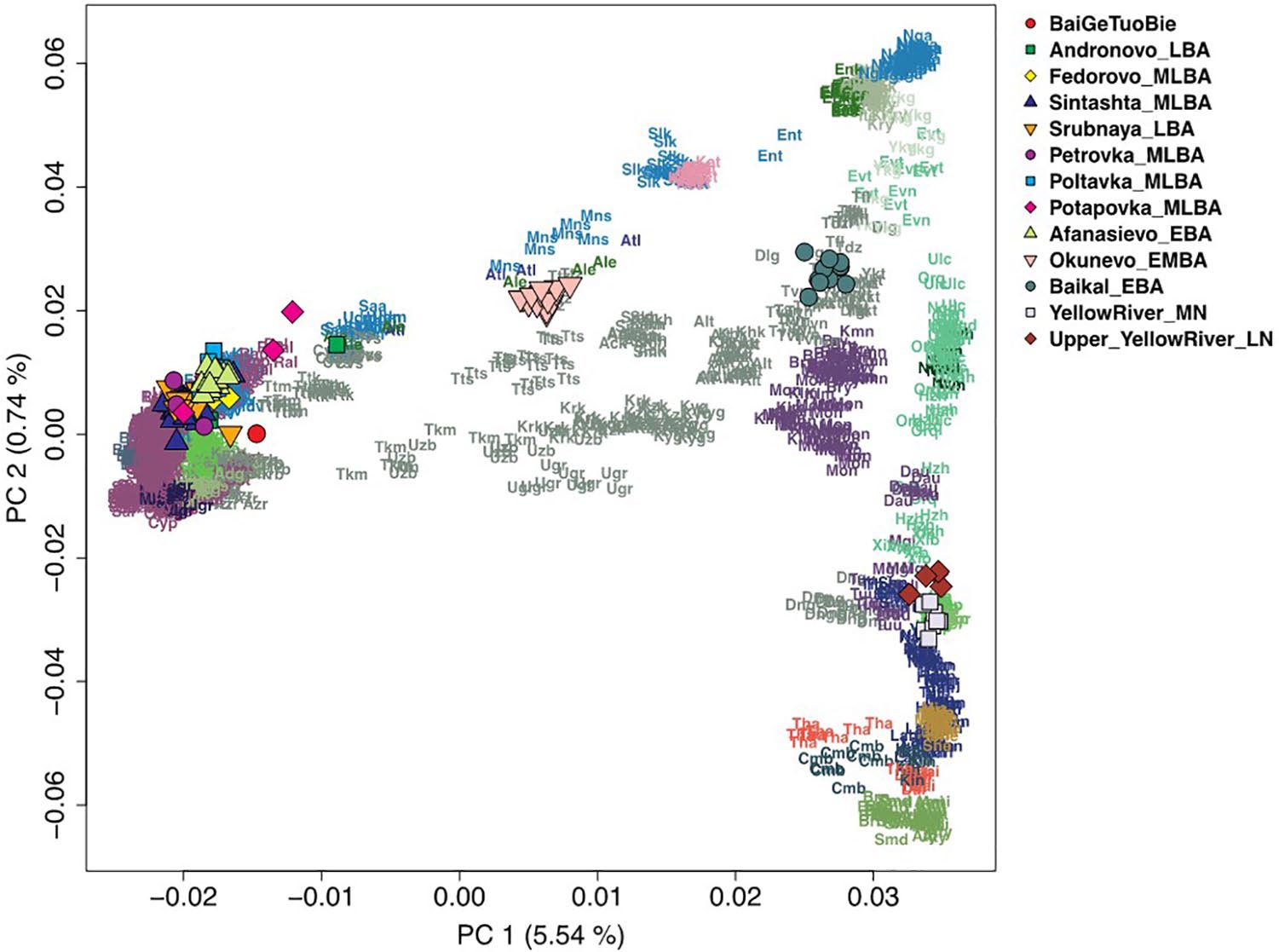Recent paper (behind paywall) The Baigetuobie cemetery: New discovery and human genetic features of Andronovo community’s diffusion to the Eastern Tianshan Mountains (1800–1500 BC), by Zhu, Zhang, et al. The Holocene (2020).
Interesting excerpts (emphasis mine):
The Baigetuobie cemetery (Balikun County, Hami City) is located on the eastern slope of the Baigetuobie Mountains, about 54 km west of the Balikun County and 40 km southwest of the Balikun Lake.
Baigetuobie cemetery
The cemetery is relatively small in scale and the burials are rather concentrated. The graves are marked on the surface by stone slabs visible from approximately 0.05 to 0.25 m above the ground, placed one next to the other to form round or square fences. The graves range in size from 3 to 8 m. These are linked in such a way as to form a “net” on the surface. We found some chambers made with large stone slabs through the rob pits. Some stone slabs have been displaced, perhaps as the result of grave robberies (Figure 8). The layout, burial structures and rituals of the Baigetuobie cemetery bear strong resemblance to supposed Andronovo culture sites in Semirech’ye and at the Xiabandi cemetery in the Pamir region of Xinjiang.

New chronological results
For Baigetuobie, the results of all samples show that the calendar ages cover a period from 1782 to 1439 BC (95.4% probability), the earliest era was 1782 to 1643 BC, and the latest was 1566 to 1439 BC. Using the plot from the OxCal calibration, we can see that this cemetery was used from the 18th century cal. BC to the 15th century cal. BC, which coincides with the age of the Andronovo culture.
Ancient DNA
Here, we collected a human tooth from M25 individual excavated from the Baigetuobie cemetery for DNA analysis. The single individual was buried in an Andronovo-like grave.
We retrieved almost complete mtDNA sequences for M25 with an average coverage of 116x, found that M25 carried an explicit western Eurasian haplogroup belonging to K1b.
We found that the M25 individual is projected closely to the western steppe herders (WSH), like Andronovo_LBA, Sintashta_MLBA, Srubnaya_LBA, and Fedorovo_MLBA, which suggesting the single one excavated from Baigetuobie cemetery in the Eastern Tianshan Mountain shared obviously genetic affinity with WSH populations. The direct visual evidence of the PCA plot was further confirmed by the outgroup-f3 statistics in the form of f3 (Mbuti.DG; X, BGTB), where X was represented by world-wide populations, top signals were observed with Eastern European Hunter-gatherer (EHG) and WSH populations, such as Poltavka, Srubnaya_LBA, and Fedorovo_MLBA, revealed significant allele sharing between M25 and other western steppe-related populations

Discussion
Baigetuobie is currently the earliest site on the slopes and valleys of the Eastern Tianshan Mountains. Numerous Bronze Age cemeteries and settlements have been surveyed or excavated in this region during the last 20 years. Most of their AMS dates are concentrated between 1300 and 800 BCE, and few sites are earlier than 1400 BCE. Their funeral ritual and grave goods seem to have no resemblance to those found in Baigetuobie. The Nanwan and Shirenzigou sites, for example (Chang, 1985; He, 1987; Ren, 2012; Shao, 2018: 44–80), consist of numerous densely distributed burials. On the surface, the burials are surrounded by round or oval stone fences, under which a vertical pit was excavated and lined on the bottom with stone or wooden slabs (Ren, 2012). The layout of the Nanwan and Shirenzigou cemeteries, the burial structures and the grave goods differ considerably from those in Baigetuobie. It is likely, therefore, that the former did not derive from the Baigetuobie and that they represent two diverse cultural traditions.
The significant difference between the Baigetuobie cemetery and the contemporaneous Tianshanbeilu cemetery in the Hami Oasis and those later indigenous Bronze Age settlements indicate that the Baigetuobie people were a small group of pastoral outlanders. There is no evidence that they communicated on a large scale with the agricultural population in the southern oasis. They may also not have developed into larger settlements or expanded into larger areas, otherwise they would have a widespread influence on the indigenous population across time.
Comments
The site is obviously very interesting to assess the populations behind the described Pre-Samoyedic substrate of Pre-Tocharian, because a similar CWC-related ancestry is also behind the variable admixture of the reported Shirenzigou individuals. However, the lack of more direct cultural connections, proper genomic investigation, and appropriate chronological transect from the region make any further interpretations impossible.
Whereas the F3 statistics combined with the PCA cluster suggest the arrival of a Steppe-related population into Baigetuobie likely associated directly with the Andronovo horizon – in contrast with the Afanasievo-related ancestry found in the Shirenzigou cline – the reported mtDNA haplogroup is uninformative, because it has been found (in its subclades K1b1 or K1b2) to date in Botai, Afanasievo, Yamnaya, Fatyanovo, or Srubnaya.
The interpretations of the authors regarding potential Andronovo-related migrations not reaching farther east based solely on this sample and the Shirenzigou individuals seems unwarranted, especially because Andronovo-related Wusun and Kangju populations are assumed to have spread later from the East. Nevertheless, based on archaeological and linguistic developments alone, such westward Andronovo-like migrations are in all likelihood unrelated to this northern migration wave.
See also
- R1b-rich Proto-Indo-Europeans show genetic continuity in Asia
- Proto-Tocharians: From Afanasievo to the Tarim Basin through the Tian Shan
- Yamnaya-like Chemurchek links Afanasievo with Iron Age Tocharians
- Samoyedic shows Yeniseic substrate; both influenced Tocharian
- Yamnaya replaced Europeans, but admixed heavily as they spread to Asia
- Iron Age Tocharians of Yamnaya ancestry from Afanasevo show hg. R1b-M269 and Q1a1
- Intense but irregular NWIE and Indo-Iranian contacts show Uralic disintegrated in the West
- Corded Ware ancestry in North Eurasia and the Uralic expansion
- Uralic speakers formed clines of Corded Ware ancestry with WHG:ANE populations
- Bronze Age cultures in the Tarim Basin and the elusive Proto-Tocharians